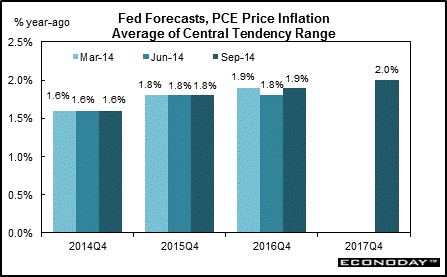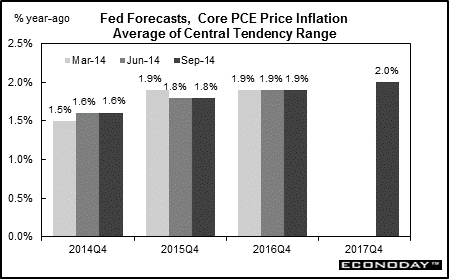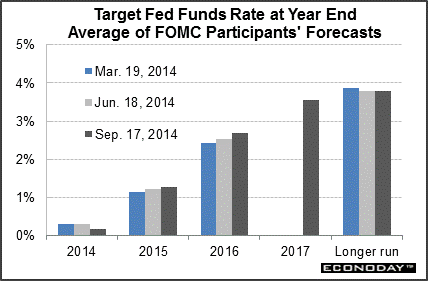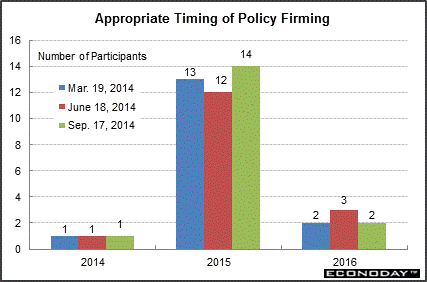
|
The Fed forecasts shown in the charts below reflect an average of the Fed forecast ranges for the last three forecasts. The official Fed forecast tables give an upper and lower range for the forecasts. The below charts show the forecasts using the average of the upper and lower range values for each indicator. It is a "central tendency" forecast in that the Fed discards the lowest and highest forecast for each indicator made by an FOMC participant. The Fed forecasts are a summary of forecasts prepared individually by each governor on the Federal Reserve Board of Governors and each regional Fed president.
In September, the Fed forecast for GDP growth for 2014 was little changed from June. The number from June had been bumped down notably due to the significant impact of notably severe weather in the first quarter on production. The recovery is projected to remain sluggish. Real GDP growth is forecast to be 2.1 percent in 2014, 2.8 percent in 2015, 2.8 percent in 2016 and 2.4 percent in 2017. These are moderate rates relative to historic averages.
The Fed lowered its unemployment rate forecast marginally in September to be consistent with this year's lower than expected rates due to a low participation rate. Still, with real GDP growth likely moderate and with productivity expected to be relatively high, the unemployment rate is projected to come down slowly over the next few years but from a lower rate than earlier expected. The FOMC participants now see an average of 6.0 percent unemployment rate in the fourth quarter of 2014 and easing to 5.1 percent by the end of 2017.
The Fed's forecasts for headline inflation were little changed. Headline PCE inflation is projected to be 1.6 percent for 2014 and gradually reaching the Fed's inflation goal of 2 percent by the end of 2017.
The Fed left its forecasts for core PCE inflation little changed. The Fed's core PCE inflation forecast is 1.6 percent for 2014 and eventually reaching 2.0 percent by the end of 2017.
Many in the Fed have indicated in recent years that they see the benefits of inflation targeting. The argument has been that if the public knows what the target is and believes the Fed will maintain inflation within the target in the long run, then inflation expectations are more firmly anchored. The Fed actually held an unannounced FOMC conference call meeting on January 16, 2009 to "discuss issues associated with establishing an explicit numerical objective for inflation"—according to the then latest FOMC minutes. No numerical targets were established but the end result of this conference call appears to have been that the committee members would submit their views on the long-term forecast for real GDP, the unemployment rate, and PCE inflation.
In recent years, "longer-run" forecasts included an unofficial inflation target. However, at the January 24-25, 2012 FOMC meeting, the Fed specifically announced a long-term "goal" of 2 percent inflation. In the following press conference, then Chairman Bernanke stated that the Fed still has a dual mandate from Congress and unemployment and inflation get equal weight in policy decision.
At the January 24-25, 2012 FOMC meeting, the Fed for the first time released in its forecasts a projection for the fed funds rate and timing for when the next rate move is expected. The forecast charts only show point forecasts for the end of the year by individual FOMC participants. Here, the point forecasts are averaged.
Regarding the fed funds rate, from the September meeting, the average forecast for the rate at the end of 2017 is just over 3-1/2 percent.
FOMC participants generally see about 3.75 percent to 4-1/4 percent as the appropriate long-run fed funds rate. With the September 17, 2014 forecasts, the Fed switched to a somewhat different set of numbers for policy rate forecasts. The Fed now focuses on a fed funds rate range and the forecasts now reflect FOMC participants' views of the mid-point of an appropriate range.
Regarding the timing of the next firming in policy, at the September 16-17, 2014 meeting, 1 participant indicated it should be in 2014, 14 in 2015, and 2 in 2016.
All forecasts are affected not just by changing views of the economy but also by annual rotation in January of voting District Bank presidents. Views may differ in terms of relative hawkishness or dovishness.
|
||||||||||
| Legal Notices | ©Copyright 1998-2024 Econoday, Inc. |
powered by
![[Econoday]](images/logo.gif)
![[Apple App Store]](/images/AppleAppStore.png) ![[Econoday on Kindle]](/images/kindle.jpg) 
|
|||||||||





